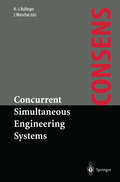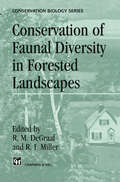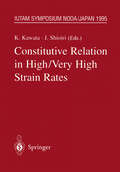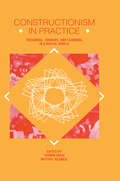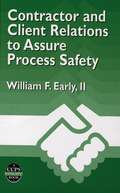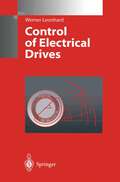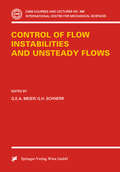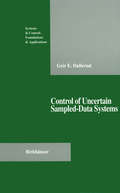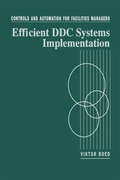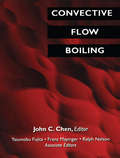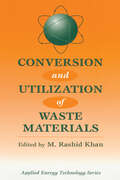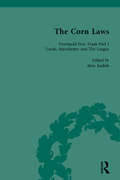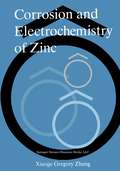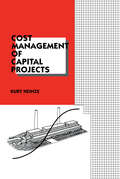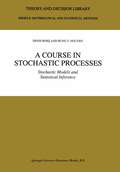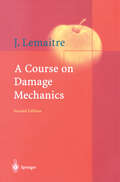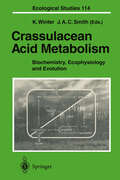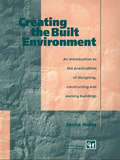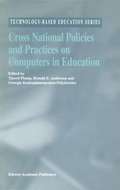- Table View
- List View
Concurrent Simultaneous Engineering Systems: The Way to Successful Product Development
by Hans-Jörg Bullinger Joachim WarschatCompetitive edge in today's world markets can only be achieved by an integrated approach to manufacturing. Concurrent or Simultaneous Engineering offers the promise of a reduced product development cycle, using complex technologies to satisfy customer demand for high quality, competitively-priced products brought to market in minimum time. The CONSENS implementation of Concurrent/Simultaneous Engineering (CSE) is an integrated package developed over recent years by some of the leading manufacturers and research institutes in Europe. It is the product of the flagship EU research project into the use of IT in Manufacturing led by the Fraunhofer Institute in Stuttgart. In particular, this study describes the management of change, network organisation, CONSENS architecture and module integration, SiFrame Management Information System, design for CSE and industrial implementations of CONSENS.
Conservation of Faunal Diversity in Forested Landscapes (Conservation Biology #6)
by Richard M. DeGraaf Ronald I. MillerForest wildlife conservation is critically required in many parts of the world today. This book presents a merger between the elements of wildlife conservation and habitat conservation, and explains how these disciplines can be used to promote the conservation of vertebrates in forests around the world.
Constitutive Relation in High/Very High Strain Rates: IUTAM Symposium Noda, Japan October 16–19, 1995 (IUTAM Symposia)
by Kozo Kawata Jumpei ShioiriThe IUTAM Symposium on Constitutive Relation in High/Very High Strain Rates (CRHVHSR) was held October 16 - 19, 1995, at Seminar House, Science University of Tokyo, under the sponsorship of IUTAM, Japan Society for the Promotion of Science, The Commemorative Association for the Japan World Exposition (1970), Inoue Foundation for Science, The Japan Society for Aeronautical and Space Sciences, and Science University of Tokyo. The proposal to hold the symposium was accepted by the General Assembly of IUT AM held in Haifa, Israel, in August 1992, and the scientists mentioned below were appointed by the Bureau of IUTAM to serve as members of the Scientific Committee. The main object of the symposium was to make a general survey of recent developments in the research of constitutive relations in high and very high strain rates and related problems in high velocity solid mechanics, and to explore further new ideas for dealing with unresolved problems of a fundamental nature as well as of practical importance. The subjects covered theoretical, experimental, and numerical fields in the above-mentioned problems in solids, covering metals, polymers, ceramics, and composites. Emphasis was given to the following fields: 1. Material characterization of solids in high velocity deformation, experimental techniques, typical data obtained by these techniques, modeling, and constitutive relations 2. Strain rate dependent elasto-visco-plastic stress waves 3. Crack initiation, propagation, and dynamic fracture toughness 4. Dynamic stress concentration 5. Structural dynamics in impact and constitutive relations of solids 6.
Constructionism in Practice: Designing, Thinking, and Learning in A Digital World
by Yasmin Kafai Mitchel ResnickThe digital revolution necessitates, but also makes possible, radical changes in how and what we learn. This book describes a set of innovative educational research projects at the MIT Media Laboratory, illustrating how new computational technologies can transform our conceptions of learning, education, and knowledge. The book draws on real-world education experiments conducted in formal and informal contexts: from inner-city schools and university labs to neighborhoods and after-school clubhouses. The papers in this book are divided in four interrelated sections as follows: * Perspectives in Constructionism further develops the intellectual underpinnings of constructionist theory. This section looks closely at the role of perspective-taking in learning and discusses how both cognitive and affective processes play a central role in building connections between old and new knowledge. * Learning through Design analyzes the relationship between designing and learning, and discusses ways that design activities can provide personally meaningful contexts for learning. This section investigates how and why children can learn through the processes of constructing artifacts such as games, textile patterns, robots and interactive devices. * Learning in Communities focuses on the social aspects of constructionist learning, recognizing that how people learn is deeply influenced by the communities and cultures with which they interact. It examines the nature of learning in classroom, inner-city, and virtual communities. * Learning about Systems examines how students make sense of biological, technological, and mathematical systems. This section explores the conceptual and epistemological barriers to learning about feedback, self-organization, and probability, and it discusses new technological tools and activities that can help people develop new ways of thinking about these phenomena.
Constructionism in Practice: Designing, Thinking, and Learning in A Digital World
by Yasmin B. Kafai Mitchel ResnickThe digital revolution necessitates, but also makes possible, radical changes in how and what we learn. This book describes a set of innovative educational research projects at the MIT Media Laboratory, illustrating how new computational technologies can transform our conceptions of learning, education, and knowledge. The book draws on real-world education experiments conducted in formal and informal contexts: from inner-city schools and university labs to neighborhoods and after-school clubhouses. The papers in this book are divided in four interrelated sections as follows: * Perspectives in Constructionism further develops the intellectual underpinnings of constructionist theory. This section looks closely at the role of perspective-taking in learning and discusses how both cognitive and affective processes play a central role in building connections between old and new knowledge. * Learning through Design analyzes the relationship between designing and learning, and discusses ways that design activities can provide personally meaningful contexts for learning. This section investigates how and why children can learn through the processes of constructing artifacts such as games, textile patterns, robots and interactive devices. * Learning in Communities focuses on the social aspects of constructionist learning, recognizing that how people learn is deeply influenced by the communities and cultures with which they interact. It examines the nature of learning in classroom, inner-city, and virtual communities. * Learning about Systems examines how students make sense of biological, technological, and mathematical systems. This section explores the conceptual and epistemological barriers to learning about feedback, self-organization, and probability, and it discusses new technological tools and activities that can help people develop new ways of thinking about these phenomena.
Contractor and Client Relations to Assure Process Safety (A CCPS Concept Book #23)
by William F. Early IIWritten and edited by engineering contractors and industry project/maintenance managers as an easy-to-use guide for other industry professionals, this book identifies important process safety issues in the contractor-client relationship,which are not addressed by other groups and publications. While the issues may arise at any point in the life cycle of a plant, they should be resolved early in the relationship to permit a clearer focus on process safety issues. Topics covered are a general discussion of contractor safety programs; EPC (engineering, procurement, construction) contractual bases and work division as they address regulatory PSM issues; subcontractor relationships; and managing contractor-client risks.
Control of Electrical Drives
by Werner LeonhardElectrical drives play an important part as electromechanical energy converters in transportation, materials handling and most production processes. This book presents a unified treatment of complete electrical drive systems, including the mechanical parts, electrical machines, and power converters and control. Since it was first published in 1985 the book has found its way onto many desks in industry and universities all over the world. For the second edition the text has been thoroughly revised and updated, with the aim of offering the reader a general view of the field of controlled electrial drives, which are maintaining and extending their importance as the most flexible source of controlled mechanical energy.
Control of Flow Instabilities and Unsteady Flows (CISM International Centre for Mechanical Sciences #369)
by G. E. A Meier G. H. SchnerrThis volume contributes to one of the most important topics of Fluid Mechanics in future and presents recent research results on control theory and applied control methods. Understanding and handling of control methods of nonlinear systems, typical of Fluid Mechanics, is the key to reduce losses and to improve the efficiency and safety of technical processes.
Control of Uncertain Sampled-Data Systems (Systems & Control: Foundations & Applications)
by Geir E. DullerudMy main goal in writing this monograph is to provide a detailed treatment of uncertainty analysis for sampled-data systems in the context of sys tems control theory. Here, sampled-data system refers to the hybrid sys tem formed when continuous time and discrete time systems are intercon nected; by uncertainty analysis I mean achievable performance in the pres ence of worst -case uncertainty and disturbances. The focus of the book is sampled-data systems; however the approach presented is applicable to both standard and sampled-data systems. The past few years has seen a large surge in research activity centered around creating systematic methods for sampled-data design. The aim of this activity has been to deepen and broaden the, by now, sophisticated viewpoint developed for design of purely continuous time or discrete time systems (e.g. J{oo or -I!l optimal synthesis, J1 theory) so that it can be ap plied to the design of sampled-data systems. This research effort has been largely successful, producing both interesting new mathematical tools for control theory, and new methodologies for practical engineering design. Analysis of structured uncertainty is an important objective in control design, because it is a flexible and non-conservative way of analyzing sys tem performance, which is suitable in many engineering design scenarios.
Controls and Automation for Facilities Managers: Efficient DDC Systems Implementation
by Viktor BoedThe first-ever complete guide to project management for facilities managers covers: how to write specifications, evaluate bids, and solve problems; all control and automation systems for new and retrofit buildings; cost-effective, energy-efficient solutions for all HVAC systems; and has complete coverage of single-building systems as well as multib
Convective Flow Boiling
by John C. ChenThis book comprises selected papers from the First International Conference on Convective Flow Boiling. The purpose of the conference is to examine state-of-science and recent developments in technology of flow boiling, i.e., boiling systems which are affected by convective flows.
Convective Flow Boiling
by John C. ChenThis book comprises selected papers from the First International Conference on Convective Flow Boiling. The purpose of the conference is to examine state-of-science and recent developments in technology of flow boiling, i.e., boiling systems which are affected by convective flows.
Conversion And Utilization Of Waste Materials
by M.Rashid KhanThis text identifies the problems and opportunities of converting wastes into useful materials or fuels. Chapters cover such issues as waste Utilization And Recycling; Plastics, Polymers, Tyres And Automotive wastes; and the potential usage of coal conversion by-products.
Conversion And Utilization Of Waste Materials
by M.Rashid KhanThis text identifies the problems and opportunities of converting wastes into useful materials or fuels. Chapters cover such issues as waste Utilization And Recycling; Plastics, Polymers, Tyres And Automotive wastes; and the potential usage of coal conversion by-products.
The Corn Laws Vol 5
by Alon KadishThe pamphlets, newspaper articles and tracts in this collection provide source material for the study of the Anti-Corn Law campaigns of the 1830s and 1840s and their role in the formation of popular economics in Britain. Volume 5 covers entries from 1839 to 1842.
The Corn Laws Vol 5: The Formation Of Popular Economics In Britain
by Alon KadishThe pamphlets, newspaper articles and tracts in this collection provide source material for the study of the Anti-Corn Law campaigns of the 1830s and 1840s and their role in the formation of popular economics in Britain. Volume 5 covers entries from 1839 to 1842.
Corrosion and Electrochemistry of Zinc
by Xiaoge Gregory ZhangHumankind's use of zinc stretches back to antiquity, and it was a component in some of the earliest known alloy systems. Even though metallic zinc was not "discovered" in Europe until 1746 (by Marggral), zinc ores were used for making brass in biblical times, and an 87% zinc alloy was found in prehistoric ruins in Transylvania. Also, zinc (the metal) was produced in quantity in India as far back as the thirteenth century, well before it was recognized as being a separate element. The uses of zinc are manifold, ranging from galvanizing to die castings to electronics. It is a preferred anode material in high-energy-density batteries (e.g., Ni/Zn, Ag/Zn, ZnJair), so that its electrochemistry, particularly in alkaline media, has been extensively explored. In the passive state, zinc is photoelectrochemically active, with the passive film displaying n-type characteristics. For the same reason that zinc is considered to be an excellent battery anode, it has found extensive use as a sacrificial anode for the protection of ships and pipelines from corrosion. Indeed, aside from zinc's well-known attributes as an alloying element, its widespread use is principally due to its electrochemical properties, which include a well-placed position in the galvanic series for protecting iron and steel in natural aqueous environments and its reversible dissolution behavior in alkaline solutions.
Cost Management of Capital Projects (Cost Engineering)
by Kurt HeinzeAiming to bridge the gap between the quantitative viewpoint of management science and the practical, day-to-day needs of project cost management, this text offers coverage of an integrated cost management programme. It presents the use of method study techniques to increase the effectiveness of procedures and improve the productivity of resources, emphasizing a systematic approach to cost control.
Cost Management of Capital Projects (Cost Engineering #27)
by Kurt HeinzeAiming to bridge the gap between the quantitative viewpoint of management science and the practical, day-to-day needs of project cost management, this text offers coverage of an integrated cost management programme. It presents the use of method study techniques to increase the effectiveness of procedures and improve the productivity of resources, emphasizing a systematic approach to cost control.
A Course in Stochastic Processes: Stochastic Models and Statistical Inference (Theory and Decision Library B #34)
by Denis Bosq Hung T. NguyenThis text is an Elementary Introduction to Stochastic Processes in discrete and continuous time with an initiation of the statistical inference. The material is standard and classical for a first course in Stochastic Processes at the senior/graduate level (lessons 1-12). To provide students with a view of statistics of stochastic processes, three lessons (13-15) were added. These lessons can be either optional or serve as an introduction to statistical inference with dependent observations. Several points of this text need to be elaborated, (1) The pedagogy is somewhat obvious. Since this text is designed for a one semester course, each lesson can be covered in one week or so. Having in mind a mixed audience of students from different departments (Math ematics, Statistics, Economics, Engineering, etc.) we have presented the material in each lesson in the most simple way, with emphasis on moti vation of concepts, aspects of applications and computational procedures. Basically, we try to explain to beginners questions such as "What is the topic in this lesson?" "Why this topic?", "How to study this topic math ematically?". The exercises at the end of each lesson will deepen the stu dents' understanding of the material, and test their ability to carry out basic computations. Exercises with an asterisk are optional (difficult) and might not be suitable for homework, but should provide food for thought.
A Course on Damage Mechanics
by Jean LemaitreThis second, corrected and enlarged edition teaches macroscopic modeling for the design, processing, testing, and control of mechanical components in engineering, and also includes the damage of interfaces and statistical damage analysis with microdefects. The first chapter deals with the phenomenology of damage, while the second couples damage to strains before going on to cover the three-dimensional situation. Chapter 3 is devoted to kinetic laws of damage evolution used by the author to unify many models, and the book is rounded off with several methods for predicting crack initiation. Detailed calculations and many exercises help students to apply the powerful techniques to practical problems in engineering.
Crassulacean Acid Metabolism: Biochemistry, Ecophysiology and Evolution (Ecological Studies #114)
by Klaus Winter J. Andrew C. SmithCrassulacean acid metabolism (CAM) represents one of the best-studied metabolic examples of an ecological adaptation to environmental stress. Well over 5 % of all vascular plant species engage in this water-conserving photosynthetic pathway. Intensified research activities over the last 10 years have led to major advances in understanding the biology of CAM plants. New areas of research reviewed in detail in this book include regulation of gene expression and the molecular basis of CAM, the ecophysiology of CAM plants from tropical environments, the productivity of agronomically important cacti and agaves, the ecophysiology of CAM in submerged aquatic plants, and the taxonomic diversity and evolutionary origins of CAM.
Creating the Built Environment: The Practicalities of Designing, Constructing and Owning Buildings
by Leslie HolesWe spend most of our lives in buildings and almost every building is unique. The purpose of this book is to explain what buildings are and to provide an integrated overview of how they are built and sustained.The book does not presume any specialist knowledge of buildings, seeking instead to explain why the different groups involved in designing, constructing, managing and occupying them follow certain procedures. It is particularly concerned with the generation and circulation of information between these groups. In taking this view, the book considers the recommendations of Sir Michael Latham's 1994 report Constructing the Team which called for better cohesion and communication between specialists in the construction industry.
Creating the Built Environment: The Practicalities of Designing, Constructing and Owning Buildings
by Leslie HolesWe spend most of our lives in buildings and almost every building is unique. The purpose of this book is to explain what buildings are and to provide an integrated overview of how they are built and sustained.The book does not presume any specialist knowledge of buildings, seeking instead to explain why the different groups involved in designing, constructing, managing and occupying them follow certain procedures. It is particularly concerned with the generation and circulation of information between these groups. In taking this view, the book considers the recommendations of Sir Michael Latham's 1994 report Constructing the Team which called for better cohesion and communication between specialists in the construction industry.
Cross National Policies and Practices on Computers in Education (Technology-Based Education Series #1)
by Tjeerd Plomp Ronald E. Anderson Georgia Kontogiannopoulou-PolydoridesThis book presents some of the results from the second stage of lEA's study of Computers in Education (CompEd). lEA, the International Association for the Evaluation of Educational Achievement, conducts international comparative studies focussing on educational achievement, practices, and policies in various countries and education systems around the world. It has a Secretariat located in Amsterdam, the Netherlands. lEA studies have reported on a wide range of topics, each contributing to a deeper understanding of educational processes. The CompEd study is a project that sheds light on the way computers have been introduced in education and on how they are being used across the world today. The study proceeded in two stages with data collected for stage 1 in 1989 and for stage 2 in 1992. Results from both stages have been published in a variety of publications. This book reports about a special part of the study. Student achievement and school processes come into being in the context of the structure and the policies of national (or regional) education systems. The variety found in the CompEd results led us to ask how much might be explained by differences in these national or regional contexts. That is the reason the CompEd study took the initiative to invite the countries participating in the study, as well as some other countries that have had interesting developments in the domain of educational computers, to write a chapter describing their policies and practices regarding computers in education.
